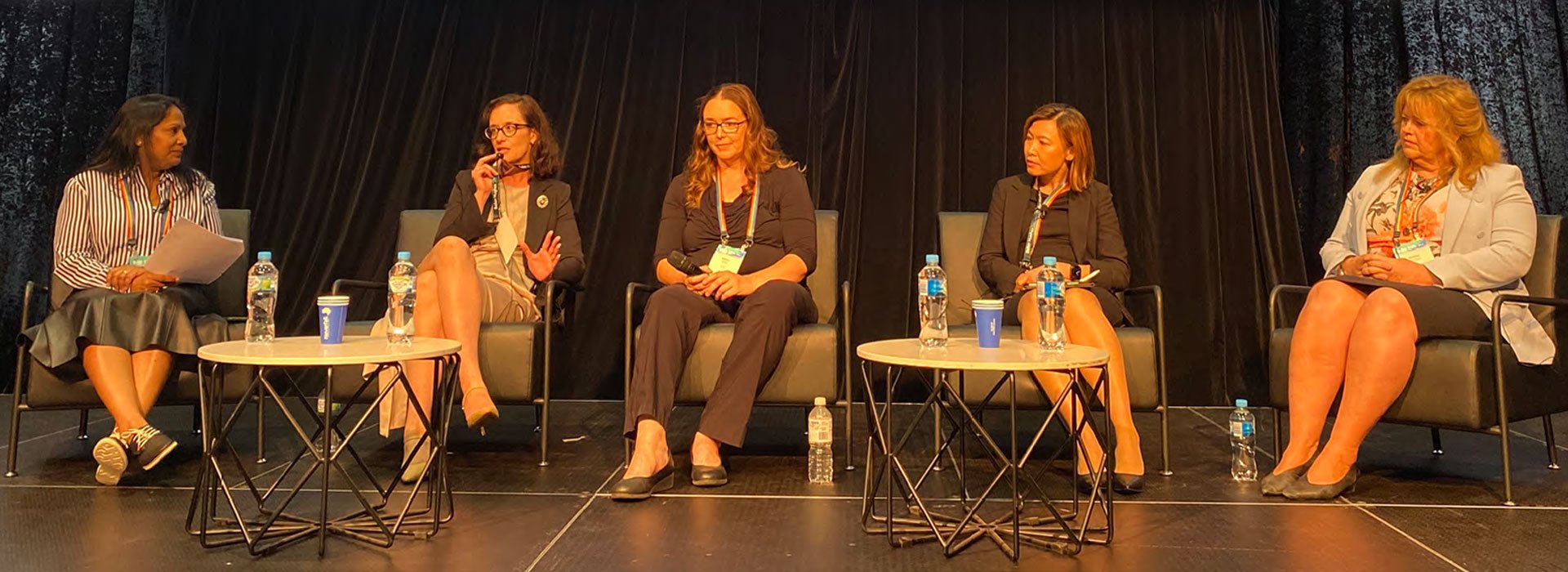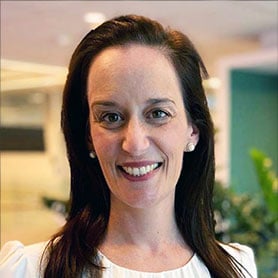Yvette Manolas: Driving decarbonisation across Woodside’s global business
Combining engineering experience, operational know-how, business acumen and a positive leadership style has enabled Yvette Manolas to drive real change right across Woodside’s global business. She met with dss+ to discuss her role, the way businesses and leaders can approach decarbonisation and sustainability more broadly, and what’s worked for her.


Yvette Manolas
General Manager and Head of Global Decarbonisation, Woodside
Q.
You’ve had a diverse career, moving across functions and roles. Can you briefly explain your journey?
I’m currently General Manager and Head of Decarbonisation at Woodside.
I took a fairly traditional engineering route to commence my career following my studies in Mechanical Engineering and Commerce at the University of Western Australia and originally joined Woodside as a graduate Petroleum Engineer. Since then, I have had many roles across exploration, projects and operations. This included a time as one of five global Subject Matter Experts (SMEs) in perforating - the use of downhole explosives – which saw me seconded to Shell to travel the world and provide advice and training on the use of those explosives. I’ve held a number of strategic roles at Woodside in my speciality of well-design, I’ve worked in flow assurance and other development and operations roles. I previously ran Woodside’s Pluto asset, oneof the company’s largest on- and off-shore assets, and I managed Woodside’s Indigenous Affairs function for a time and created the first outcomes-based Reconciliation Action Plan in Australia.
I am now leading Woodside’s approach to decarbonisation, and I’m also on a couple of Boards including with the C02 CRC and Earth Science Australia.
My current role is really varied, every day is different, but what I love most is the opportunity I have to apply my leadership skills, to be innovative and strategic, to bring together people with diverse skill sets. And most importantly, I have the chance to make a real difference.
“My career journey also demonstrates the key role that engineering, geoscience and scientific skills can play in a Paris aligned world. These skills are universal and you can apply them in lots of ways. A lot of new and different ways. That includes contributing to the energy transition.”
– Yvette Manolas, General Manager and Head of Global Decarbonisation, Woodside
Q.
What would you say are businesses’ major challenges to moving to a lower carbon and sustainable future? What is getting in their way at present?
The science is clear: the world is warming due to human-induced changes and limiting global temperature rises will limit those impacts. On that basis, you could assume that it should be easy and straightforward to move to lower carbon emissions as the science is relatively undisputed.
But it’s really complex because there is no one size fits all approach, no ‘cookie cutter’ or ‘off the shelf’ map to follow.
Many of the complexities are well described by the United Nations’ Sustainable Development Goals, which encompass challenges linked to people’s prosperity; access to food; access to water; and maintaining sustainable economies, amongst others. Everything you do as a business must balance against all of these factors. But you also need to balance against energy security, regulations in your current jurisdiction, political positioning, your geographical advantages or disadvantages and geopolitical issues.
Then overlay demand for energy, supply of energy, individual consumer behaviours – and then overlay that again with the cost of any proposed changes.
It gets complex very quickly for business to navigate. Which path should you follow?
It’s worth noting that the International Energy Agency (IEA) has highlighted three potential scenarios around the way the world may transition. By comparison, the UN’s Intergovernmental Panel on Climate Change (IPCC) has released more than 2000 scenarios.
It is this complexity that can make it hard for businesses to know where and how to start their journey. Some business will develop a plan focused on just one or two scenarios, thinking this will simplify their approach. But what we’re seeing is no one knows which of these climate scenarios are the most likely, what the future will actually be. And so we’ve found flexibility is key: you need to develop a climate or sustainability strategy that is adaptable and reflects your company values. You must also leverage the opportunities created through the process, and be clear on the related costs your business can carry. I’d recommend taking a holistic view of the whole issue, but being able to pivot as your value chain and macro-economic environment evolves.
“It’s critical not to fixate on a single path but come up with a number of strands to your strategy so that you can pivot as things change.”
– Yvette Manolas, General Manager and Head of Global Decarbonisation, Woodside
Q.
Based on your own experience and what you hear from your peers, what are some of the ways to embed sustainability initiatives successfully in an organisation?
Talking to my peers, we have regular conversations about how to create and maintain internal traction for sustainability initiatives. Like any change journey, there doesn’t tend to be lightbulb moment when a team member suddenly switches from being guarded to fully embracing the company’s approach. Rather, success is pre-conditioned by a few key elements:
Back your company’s sustainability vision. A lot of companies have sustainability vision statements; what’s sometimes missing is a clear demonstration the vision is embodied at all levels of the organisation. The CEO, the Board and all other leaders must show they have total belief in the vision. What’s also often missing are clear outcomes, so people understand what they’re aiming for. Be bold when setting that vision and these outcomes you want to realise.
Ensure your people are set up for success: it seems obvious, but sometimes the obvious needs to be stated. In this case, making resources and budgets available, establishing processes and decision-making frameworks, communicating financial decision making criteria and finally ensuring everyone is fully aware what success looks like for them – are all really critical parts.
Drive the right culture: ensure through your actions that people trust and believe what you are saying and be present. How do you keep a pulse check on your team and the organisation? I regularly have coffee catch-ups within the business to check in on progress and identify any challenges and ways to support people to be successful. Our people usually have the solutions. They know what would enable them to deliver the vision. If I can respond by removing some blockers or putting additional support in place, we’ll see even more traction.
“Usually, people are excited by a bold vision, as long as they believe it’s achievable. They need to feel set up for success.”
– Yvette Manolas, General Manager and Head of Global Decarbonisation, Woodside
In terms of embedding sustainability, one practical example that’s worked really well for us is the Woodside Energy Climate Awareness Network which is employeeled and supported by executive sponsors. Through this network, during a two-week program dedicated to climate, more than 1000 employees participated in sessions with internal experts, heard from guest speakers including the International Energy Agency and joined technical workshops. These open conversations really helped the whole business move forward in our understanding of climate change, and what we want to achieve as a company.
Q.
What are you doing on a global level to implement change across your whole value chain?
There are so many companies in our value chain doing great work in sustainability. I’ll highlight one current initiative in alignment with the Methane Guiding Principles, which focuses on methane across value chains. Woodside wanted to understand methane emissions across our value chain of suppliers and customers. We then thought that other companies may be interested to join us on this journey and reach out to their value chains to understand, measure and reduce methane emissions.; and thus the Midstream Methane Reduction Group commenced.
Twenty companies joined the initial workshop. We were really happy with that actually, but what’s been amazing was seeing the snowball effect. We had really in-depth, open conversations, and those companies who joined the initial session spoke to their networks – one referred an additional 50 organisations. The impact has been cascading with more and more organisations interested in reducing their methane emissions footprint.
New initiatives like this can seem slow at the start, but with diligence, you can build momentum and create change. Create a coalition, and together you can achieve great things.
Q.
What are the top 3 characteristics of a successful Sustainability Leader?
In addition to bringing your own technical skills and leadership approach, I do believe you need to showcase three key characteristics:
Integrity: to drive cultural change people need to see you demonstrate integrity through your actions; otherwise your credibility will be very short-lived
Innovation and passion: you are going to have to do things differently and be comfortable in uncharted territory at times, and you’ll need to rely on your passion and belief in the change to bring others along on the journey.
A business mindset: whether you’re privately owned or publicly-held, you always need to justify expenditure to someone and demonstrate the business case. Bringing together sustainability thinking, the business case and the right culture will facilitate significant change.
And more generally, you need to understand this is an issue that a lot of people are really passionate about it; it really does speak to their value system.
I think as a leader, you really need to understand what drives your team as well as the whole business, to really use those levers in a way that resonates for all – or for as many as possible. It’s a delicate balance.
Q.
What initiative or action have you taken in your career that’s made a difference and that you’re most proud of?
I am very proud to be part of the team that is driving decarbonisation and emissions reductions at Woodside – it’s a large, widespread effort by a great number of very motivated people, sustainability specialists, , advocates, and our leaders throughout the business. My contribution has been to provide coordination, purposeful structure and planning to support the company-wide effort.
We are still on our journey but one measure of success is that this work is deeply embedded and doesn’t rely on a single person in a role, such as mine, to progress the journey anymore.
I am proud that we now have strengthened capacity and capability for decarbonisation at Woodside – through our employee network, established frameworks and processes in place to make financial decisions and focus on a strong outcome-driven vision.
“It’s been a bold journey internally in a relatively short space of time. Climate is now embedded in all conversations and in everything we do, in all business cases. I’m proud of my and my team’s contribution to that.”
–Yvette Manolas, General Manager and Head of Global Decarbonisation, Woodside
I’ve had a favourite quote from Michelangelo for many years – “the greatest danger for most of us is not that our aim is too high and we miss it, but that it is too low and we reach it.” I would prefer to try and fail than not to have tried at all.